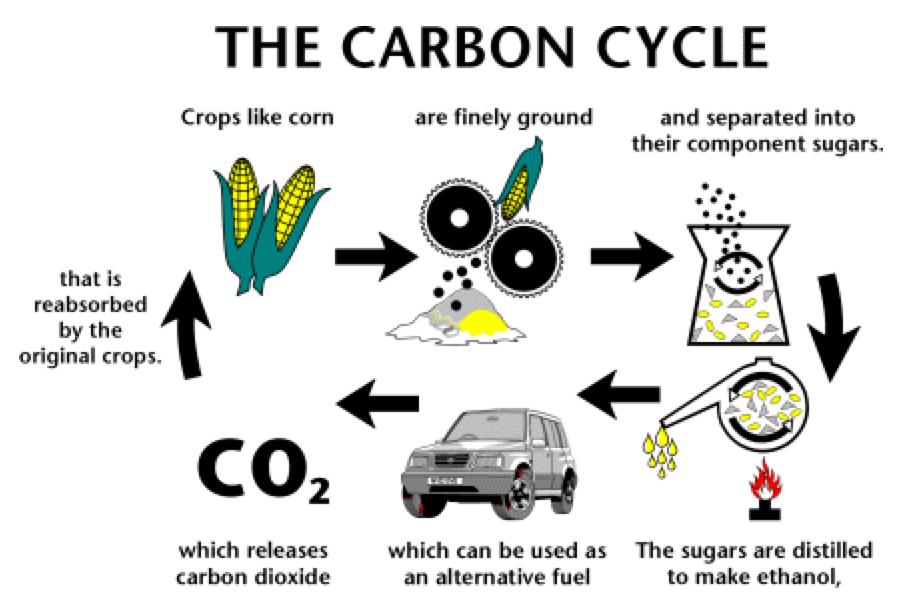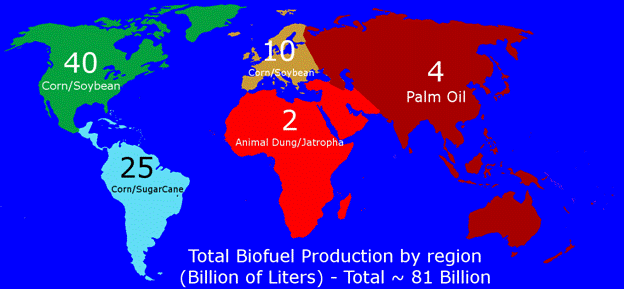Biofuels are a type of renewable energy resource produced from modern biological processes, through the employment of agriculture as well as anaerobic digestion. Research and development of biofuels are extremely useful because they, along with other renewable sources of energy, such as geothermal, solar, wind, tidal, wave and the others, can be used instead of fossil fuels and other exhaustible energy sources. Not only have biofuels proved themselves as a functioning alternative to the latter, but their creation process creates opportunities for industrial waste recycling and conversion.
The focus of this report is the nature and qualities of biofuels. It will study how it is produced, where and how it is used and in what quantities. The efficiency of this type of fuel will be looked at in detail, and compared to other energy sources, both fossil fuels and alternative.
Finally, this report will evaluate the pros and cons of biofuel application in the society, what benefits it provides and what difficulties are faced by industries and individuals who employ it.
Description of Biofuels
It is important to understand that biofuel is not a novel concept, and have been considered for use since the beginning of the 20th century and the development of the first cars. For example, Henry Ford considered using ethanol to power some of his early car models. In the similar vein, diesel engines were originally designed to run on fuel obtained from peanut oil and was seen by its inventor Rudolf Diesel as a way boost the development of agriculture and economies in the countries that would use it (The History of Biodiesel, n.d.). Diesel’s ideas were ahead of his time, as when he first introduced them the market was reliant on much cheaper petroleum. But nowadays, with the prices on oil and gas steadily rising, biofuel is becoming a much more appealing endeavor.
One of the main selling points of biofuel is its seeming near-zero emission lifecycle. Crops like sugarcane, corn, palm oil, or similar, are converted into fuel. The fuel can be used in internal combustion engines, either in a mix with gas or on its own, and the produced carbon dioxide would eventually be absorbed by the same purpose-grown crops.

Countries around the world are already using biofuel of different kinds as vehicle and transportation fuel. For example, biodiesel made from palm oil is available on demand in countries around Europe, and Brazil, a major sugarcane exporter, makes ethanol out of it and uses it as fuel for modified cars. This is not new since traditional gas often has ethanol added into it (Biofuels: The Original Car Fuel, n.d.).
The type of biofuel produced and used in the country is dependent on the kind of crops grown by its agriculture, as well as the government policies and support. America and Europe focus on biofuel produced from Corn and Soybean; South America – Corn and Sugar Cant; Australia and Asia convert palm oil; and Africa and the Middle East majorly use animal excrement and jatropha (Major Biofuel Producers by Region, 2010).

The image above shows the billions of liters of biofuel different world regions produce per year as of 2010. At the moment, Europe is the biggest biodiesel developer, accounting for more than 53 percent of worldwide biofuel production, while the United States and Brazil produce more than 90 percent of total ethanol volume (Biofuels Make a Comeback Despite Tough Economy, 2011).
Overall, biofuels seem to be like a great solution to the increasing oil and gas prices. They are a renewable resource, which produces between 25 to 90 percent less carbon dioxide, depending on the type of feedstock used, and seemingly cost less per liter compared to fossil fuel. However, a gallon of gasoline can provide up to 124,800 British thermal units (1 BTU equivalent to 1055 joules) compared with 80,000 BTU for the same amount of ethanol. While the energy output is impressive, an ethanol-run car would have to be refueled more often, leading to higher expenses. Also, a lot of energy is spent growing the crops and running the production process, which begs the question of biofuels redeem the amount spent on them (Roos, 2012)?
Discussion
Application of biofuels yields both benefits and problems for the energy industry. To create an accurate, objective understanding of biofuel and its value for our modern society, it is important to discuss its pros and cons in detail.
The main marketing points of biofuels are their supposed environmental friendliness compared to fossil fuels, and their availability as a renewable resource. This makes biofuels a highly researched topic in countries reliant on oil and other finite energy resources, for example in the United Arab Emirates and the United States of America.
Also, while first generation biofuels such as ethanol are produced from the sugars and vegetable oils, the second-generation biofuels can be made from agricultural and some types of industrial waste, as well as woody crops, which is very helpful for the recycling industry.
Finally, biofuel farmlands create job opportunities in developing countries, creating a potential to reduce poverty, if the appropriate local government and global support are provided.
On the other hand, there are numerous social, economic, political, logistical and efficiency factors which keep biofuels from becoming the universal solution of the modern fuel industry problems. These fuels are very reliant on crop harvests, and this is not good for business.
Also, the argument about ethanol, for example, being a cleaner, safer fuel than gas does not take into account the amount of pollution produced and energy spent during the crop growth and reaping, which makes the numbers harder to evaluate and raises the question of the final product covers its costs. First generation biofuel also needs wide stretches of land to be devoted to producing the original biomass, land that can no longer be used for food crops. The increased demand for gas alternatives can threaten both the existing food farmlands and natural habitats, with consequences such as soil erosion and deforestation.
And finally, all kinds of biofuel production are heavily reliant on water resources in many phases of development. This can create a lot of controversy, considering heavy water deficiency in some of the regions of the world (Roos, 2012).
While these negatives may stall the development of biofuels, it is an undeniable fact that world governments are in search of gas and oil alternatives and will continue to fund research into the improvement of the biofuel production process and energy output. Studies are being done on sustainable biofuel, which will not be detrimental on food and fiber industries, and will not create environmental problems.
Conclusions
Various studies which evaluate the downsides of biofuel and its production ultimately fail to mention the similar downsides to fossil fuel, its extraction, and production. The current principal value of biofuel is its role as an alternative to gas. While researchers are hopeful that, in the future, these fuels will be self-sustaining and completely environmentally safe, the demand for them will keep increasing as the oil deposits dwindle.
References
Biofuels Make a Comeback Despite Tough Economy. (2011). Web.
Biofuels: The Original Car Fuel. (n.d.) Web.
Carbon Cycle as a Closed Loop [Digital Image]. (n.d.) Web.
Major Biofuel Producers by Region. (2010) Web.
Major Biodiesel Producers by Region [Digital image]. (2010) Web.
Roos, D. (2012). Biofuels vs. Fossil Fuels. Web.
The History of Biodiesel. (n.d.) Web.